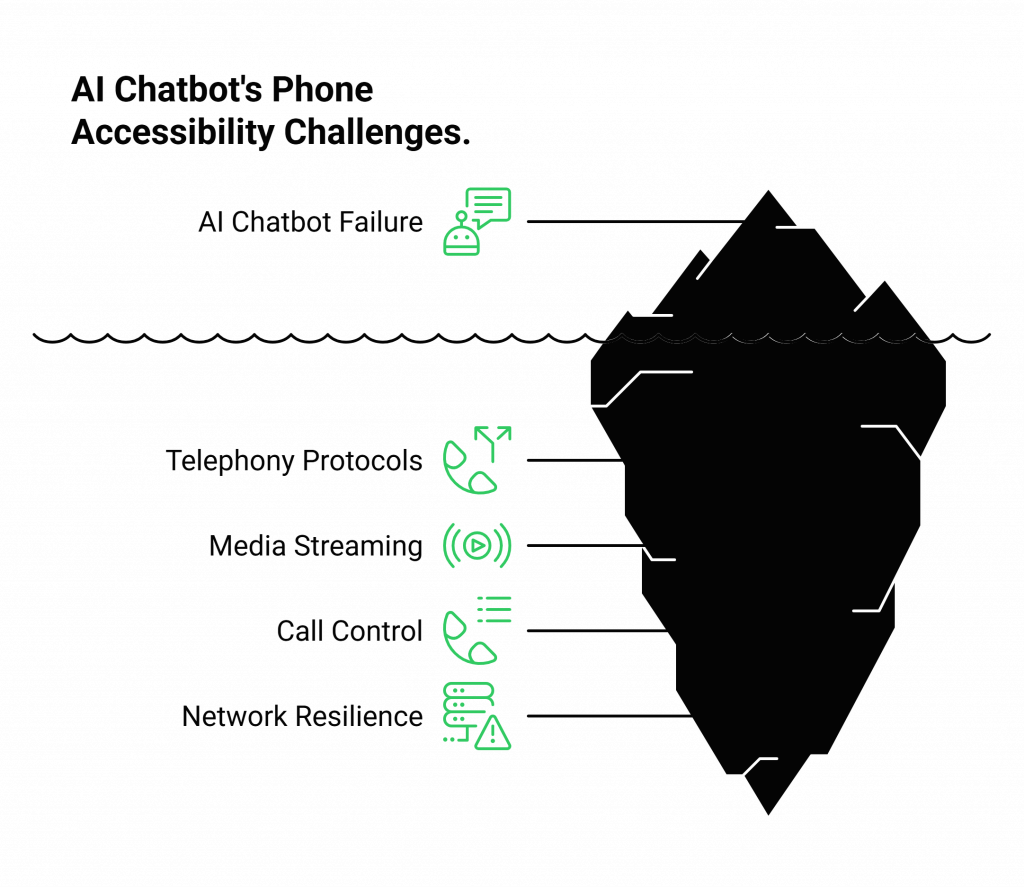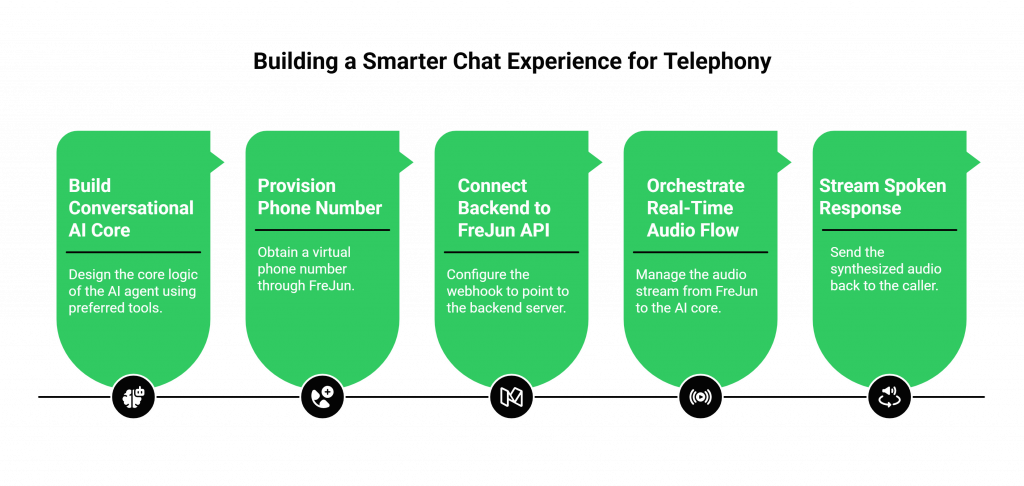The evolution of the chatbot has been remarkable. We’ve moved from clunky, keyword-driven bots to sophisticated conversational agents capable of understanding context, detecting emotion, and personalizing interactions. The pinnacle of this evolution is the Smarter Chat experience.
Table of contents
- What Makes a Chat “Smarter”? It’s More Than Just AI
- The Accessibility Gap: Why Most “Smarter Chat” Fails on the Phone
- FreJun: The Voice Infrastructure Layer for Your AI
- The Two Paths to a Voice-Enabled Chat Bot: A Comparison
- How to Build a Smarter Chat Experience for Telephony? (Step-by-Step)
- Best Practices for Designing a Superior Conversational Experience
- Final Thoughts: Your AI is Smart, But Can It Answer a Call?
- Frequently Asked Questions (FAQ)
A fusion of advanced artificial intelligence with the natural interface of the human voice. This combination promises to revolutionize how businesses interact with their customers, offering 24/7 availability, unparalleled accessibility, and deeply engaging conversations.
Developers are leveraging powerful platforms like Rasa, Voiceflow, and Google’s Conversational AI to build the “brains” of these intelligent agents. The AI is becoming more human-like every day. Yet, a critical gap persists that prevents most businesses from realizing the full potential of their investment. A bot’s intelligence is only as valuable as its accessibility, and for a vast number of customers, the most critical point of access is the telephone.
What Makes a Chat “Smarter”? It’s More Than Just AI
A truly Smarter Chat experience goes beyond simply responding to queries. It’s an interactive, multi-sensory dialogue built on a foundation of several key technologies:
- Automatic Speech Recognition (ASR): The ability to accurately transcribe spoken words into text in real time.
- Natural Language Processing (NLP): The use of Large Language Models (LLMs) to understand user intent, manage context, and even analyze sentiment.
- Text-to-Speech (TTS): The synthesis of AI-generated text into lifelike, expressive voice responses.
- Business System Integration: The capacity to connect to CRMs, helpdesks, and other backend systems to provide personalized, contextual automation.
When these elements are combined, the result is an experience that feels less like interacting with a machine and more like talking to a competent, helpful assistant. This is the new standard for customer engagement.
The Accessibility Gap: Why Most “Smarter Chat” Fails on the Phone
You’ve built a brilliant AI agent. It’s emotionally intelligent, it has persistent memory, and it provides a fantastic experience within your web or mobile app. Now, you need it to handle your company’s support hotline. This is where most projects hit a formidable and unexpected wall.

The platforms and APIs used to build the AI’s logic are not designed to interface with the global telephone network. The Public Switched Telephone Network (PSTN) is a complex and archaic ecosystem that operates on a completely different set of rules from the modern web. To connect your bot to a phone number, you would have to build a highly specialized infrastructure stack from scratch, forcing your team to become telecom experts and solve problems like:
- Telephony Protocols: Managing complex SIP (Session Initiation Protocol) trunks and negotiating with carriers to connect to the PSTN.
- Real-Time Media Streaming: Building and maintaining dedicated media servers to handle raw audio streams from thousands of concurrent calls.
- Call Control and State Management: Architecting a system to manage the entire lifecycle of every call from ringing and connecting to holding and terminating.
- Network Resilience: Engineering solutions to mitigate the jitter, packet loss, and latency inherent in voice networks that can destroy a conversation’s quality.
This is the accessibility gap. A bot that cannot be reached by a simple phone call is not a complete solution for most businesses. A truly Smarter Chat must be available on the channels your customers actually use, and for critical inquiries, that channel is often the phone.
FreJun: The Voice Infrastructure Layer for Your AI
This is the exact problem FreJun was built to solve. We are not another AI platform that competes with the tools you already use. FreJun is the specialized voice infrastructure layer that allows you to connect the Smarter Chat agent you’ve already built to the telephone network.
We provide a simple, developer-first API that handles all the complexities of telephony, so you don’t have to.
- We are model-agnostic: You bring your own AI “brain.” Whether you’ve built it with Rasa, Dialogflow, OpenAI, or a custom framework, we can connect it.
- We manage the voice transport: Our platform handles the phone numbers, the SIP trunks, the media servers, and the low-latency audio streaming.
- We integrate with your backend: All your application sees is a clean, bi-directional audio stream delivered over a standard WebSocket.
FreJun is the missing piece of the puzzle. We provide the robust, scalable, and reliable connection that makes your intelligent agent universally accessible.
The Two Paths to a Voice-Enabled Chat Bot: A Comparison
| Aspect | The DIY Telephony Approach | The FreJun Platform Approach |
| Infrastructure Focus | Building and maintaining voice servers, SIP trunks, and PSTN interconnects. | Integrating a single, simple voice API into your existing backend. |
| Developer’s Role | Becomes a hybrid backend developer and telecom engineer. | Remains focused on AI logic, conversation design, and business value. |
| Time to Market | Months, or even years, to build a stable, scalable system. | Days or weeks to deploy a production-ready telephony voice bot. |
| Scalability | Extremely difficult and costly to scale for high call concurrency. | Built on a globally distributed, enterprise-grade platform that scales on demand. |
| Maintenance | Continuous, complex maintenance of telephony hardware and software. | Zero telephony maintenance. FreJun handles all infrastructure and uptime. |
Pro Tip: Design for a Seamless Handoff
A key component of a Smarter Chat experience is knowing when the AI has reached its limits. Design your conversational flow with a clear and seamless handoff process to a human agent. FreJun’s API makes this easy, allowing your bot to programmatically transfer the call to a live support queue, ensuring the customer never hits a dead end.
How to Build a Smarter Chat Experience for Telephony? (Step-by-Step)
This guide outlines the modern architecture for making your AI bot accessible over the phone using FreJun.

Step 1: Build and Perfect Your Conversational AI Core
First, focus on what you do best. Use your preferred platforms and tools (like Voiceflow, Rasa, or custom LLM integrations) to design the core logic of your conversational agent. This “brain” should be able_ to process an input and generate a response, independent of the channel.
Step 2: Provision a Phone Number with FreJun
Instead of negotiating with telecom carriers, simply sign up for FreJun and instantly provision a virtual phone number through our dashboard. This number is now the public-facing identity for your AI agent.
Step 3: Connect Your Backend to the FreJun API
In the FreJun dashboard, configure your new number’s webhook to point to your backend server’s WebSocket endpoint. This tells our platform where to send live call data. Our server-side SDKs for popular languages make handling this connection simple.
Step 4: Orchestrate the Real-Time Audio Flow
When a customer dials your FreJun number, our platform answers the call and establishes a real-time audio stream to your backend. Your code will then:
- Receive the raw audio stream from FreJun.
- Pipe this audio to your existing ASR service to be transcribed.
- Send the transcribed text to your AI “brain” for processing.
- Take the AI’s text response and send it to your TTS service for synthesis.
Step 5: Stream the Spoken Response Back to the Caller
As your TTS service generates the synthesized audio, you stream it directly back to the FreJun API. Our platform handles playing it to the caller over the phone with ultra-low latency, creating a fluid and natural Smarter Chat experience.
Key Takeaway
A truly Smarter Chat solution is built on two distinct pillars: advanced conversational intelligence and universally accessible voice infrastructure. While many platforms help with the first pillar, the second remains a massive engineering challenge for most companies. FreJun provides this second pillar as a simple, powerful API, allowing you to focus on building the best possible AI while we handle the complexities of connecting it to the world.
Best Practices for Designing a Superior Conversational Experience
- Prioritize Low Latency: A natural conversation requires speed. While FreJun provides a low-latency transport layer, ensure your entire AI pipeline (ASR, NLP, TTS) is also optimized for a fast response.
- Maintain Persistent Context: An intelligent conversation requires memory. Use a fast database or in-memory cache to store the context and history of each call, allowing your bot to have more meaningful, multi-turn dialogues.
- Ensure Cross-Channel Consistency: If your bot is available on both your website and the phone, ensure the personality, knowledge, and capabilities are consistent across both channels for a unified brand experience.
- Disclose and Be Transparent: Always inform users that they are speaking with an AI. This builds trust and ensures compliance with emerging regulations.
Final Thoughts: Your AI is Smart, But Can It Answer a Call?
The journey toward a truly Smarter Chat experience is one of the most exciting frontiers in software development. The AI is becoming more capable every day, with a deeper understanding of language, emotion, and context. But all of this intelligence is of limited use if it’s locked away inside an app or a website.
The ultimate test of a business-ready AI is its ability to meet customers where they are. For millions of people, that place is the telephone. By partnering with a specialized voice infrastructure platform like FreJun, you can bridge the accessibility gap and unlock the full potential of your AI investment. You can move beyond building a clever chatbot and start deploying a powerful business tool that can listen, understand, and serve your customers on a global scale.
Let us handle the phone lines, so you can focus on making your chat smarter.
Further Reading – The Benefits of Using AI Insight for Call Management: A Comprehensive Guide
Frequently Asked Questions (FAQ)
No. FreJun is a model-agnostic voice infrastructure platform. We provide the essential API that connects your application to the telephone network, giving you the freedom to build your AI with any platform or tools you choose.
All-in-one platforms often bundle the AI logic and the communication channels together, which can limit flexibility. FreJun is different. We focus exclusively on providing the best-in-class voice transport layer, giving you maximum control to build a truly custom Smarter Chat experience with your preferred AI stack.
Conversational memory and state are managed within your own backend application. FreJun provides a unique session ID for each call, which you can use as a key to store and retrieve the conversation history from your database or cache. Our platform focuses purely on the transport of the audio.
Yes. FreJun’s API provides full call control, including the ability to programmatically initiate outbound calls. This allows you to use your AI agent for use cases like automated appointment reminders, feedback surveys, or lead qualification.
The main benefits are speed, cost, and focus. Building a production-grade, scalable telephony system is a massive undertaking that can take years and millions of dollars. FreJun provides this as a fully managed, enterprise-grade service, allowing you to launch in weeks and focus your valuable engineering resources on your core product.
